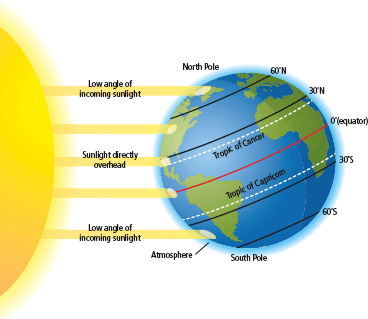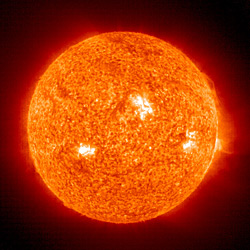Describe the Sun's Role in the Sustainability of Earth's Environment
Animals including humans need plants for food and the oxygen they produce. It also influences Earths climate.

1 Causes Of Global Climate Change The Geographer Online
Putting the suns role in the climate into context as Haigh does is important.

. Plants need sunlight to grow. The Sun is a restless object that is wracked by magnetic storms flinging electrified gas into space creating space weather. From the surface of another celestial body as a delicate living jewel in the vast dark sea of space.
Like the chromosphere the suns corona can only be seen during a total solar eclipse or with NASAs Solar Dynamics Observatory. The sun is an ordinary star one of about 100 billion in our galaxy the Milky Way. The Sun can influence the Earths environment in a variety of ways and on different time scales.
But the warming weve seen in recent decades is too rapid to be linked to changes in Earths orbit and too large to be caused by solar activity. The Sun is a giver of life. In 2019 solar power provided around 3 of global electricity mostly through solar panels based on photovoltaic cells PV.
The panels are mounted on top of buildings or installed in utility-scale solar parks. The work suggests counterintuitively that when the sun is at the dimmest point of its 11-year solar cycle as it was in December 2009 it warms the Earth most and vice versa. Heat causes liquid and frozen water to evaporate into water vapor gas which rises high in the sky to form cloudsclouds that move over the globe and drop rain and snow.
We know subtle changes in Earths orbit around the Sun are responsible for the comings and goings of the ice ages. Thats because almost all living things rely on the steady light and heat of the Sun. H 07 340 W m 2 238 W m 2.
If we preserve the environment then we are giving back to the planet. But earth also responds to the rising amount of energy being trapped as humans add more greenhouse gases to the atmosphere. The Sun warms the planet drives the hydrologic cycle and makes life on Earth possible.
Sustainability is an interdisciplinary study that aims to save our environment but also maintain our quality of life. Since the Sun is by far the largest supplier of energy to the Earths surface any change in the radiative output of the Sun also affects the energy balance of the Earths surface. The idea of sustainability borrows from many different fields of study such as chemistry physics as well as.
This process is a large part of the water cycle. In 1969 the Earth was first viewed in a new way. And all life that we know of from bacteria to elephants needs liquid water to survive.
The sun has extremely important influences on our planet. From solar arrays and fuel cells to Earth-observing satellites more efficient. Life on Earth would cease to exist.
It radiates light and heat or solar energy which makes it possible for life to exist on Earth. Solar energy also evaporates water that falls as rain and builds up behind dams where its motion is used to generate electricity via hydropower. We know subtle changes in Earths orbit around the Sun are responsible for the comings and goings of the past ice ages.
This is a major reason why we should take care of the earth. The Sun-climate connection. If we want to protect our environment here is a guide on how to take care of the earth.
Principle 1 sets the stage for understanding Earths climate system and energy balance. In general sustainability is understood as a form of intergenerational ethics in which the environmental and economic actions taken by present persons do not diminish the opportunities of future persons to enjoy similar levels of wealth utility or welfare. The Sun transmits its influence to the Earth essentially by gravitation electromagnetic radiation and particle emission solar wind and energetic particles.
Sustainability the long-term viability of a community set of social institutions or societal practice. The idea of sustainability. The sun is what makes the water cycle work.
The sustainable shelter section presents some ideas for alternative housing and low-impact shelter and living. Framework shows the Suns significant regulatory role. Its clear that the planet responds to changes in the amount of energy it receives from the sun.
The basic characteristics of the Sun are described as the background that determines the permanent features of the near Earth environment. It drives weather ocean currents seasons and climate and makes plant life possible through photosynthesis. The Sun is the source of most of the energy that drives the biological and physical processes in the world around usin oceans and on land it fuels plant growth that forms the base of the food chain and in the atmosphere it warms air which drives our weather.
The Suns heat makes liquid water on our planet possible. Issues about climate change and environmental refugees are also stored inside this section. The third layer of the suns atmosphere is the corona.
All roads to sustainable energy lead to the sun Menu Close. The Suns energy warms the planets surface powering titanic transfers of heat and pressure in weather patterns and ocean currents. How Can We Save Our Earth.
The Sun is Earths primary source of energy a clean and abundantly available resource in many regions. List of Best Palm Oil Free Products. The Sun powers life on Earth.
The sun provides what almost everything on Earth needs to goenergy or heat. Changes in the Suns brightness can change global temperatures. Direct satellite measurements since the late 1970s show no net increase in the Suns output while at the same time global surface temperatures have increased Figure 2.
It is an extensive field of study encompassing the environment social sciences technology business and others. It helps keep the planet warm enough for us to survive. Due to reflection by the atmosphere clouds and Earths surface we can approximate that 70 of solar energy incident on the edge of the Earths atmosphere is actually absorbed by the Earth.
It shows that the Sun-Earth system is electromagnetically solar radiation magneto-hydrodynamically Solar Wind and Coronal Mass Ejections CMEs and gravitationally lunisolar tides coupled dominated by significant non-linear non- stationary interactions. Even at a distance of 150 million kilometers 93 million miles its gravitational pull holds the planet in orbit. The olive green section nick-named sustainable earth contains some environmental issues and the climate change debate in Australia.
If harnessed properly the sun holds tremendous potential to provide sustainable energy for the earth. The Sun provides the primary source of energy driving Earths climate system but its variations have played very little role in the climate changes observed in recent decades. The Sun is the primary source of energy for Earths climate system is the first of seven Essential Principles of Climate Sciences.
It helps keep the planet warm enough for us to survive. Taking this into account the actual average amount of solar energy absorbed by the Earth amounts to. Since then NASA has contributed in many areas to our understanding of the Earth and to our need for cleaner greener technologies.
The resulting air currents drive wind turbines. The rate of energy coming from the Sun changes slightly day to day. Some of this material collides with the Earth causing the colourful aurorae and many other effects.
The sun is the closest star to Earth. Make Use of 3R Waste Management.

What Is The Greenhouse Effect Greenhouse Effect Greenhouse Earth Atmosphere
.jpg)

No comments for "Describe the Sun's Role in the Sustainability of Earth's Environment"
Post a Comment